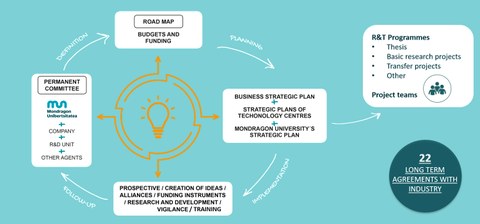

The Social Economy and the Fourth Industrial Revolution
It represents important and very real trends, but unfortunately, most of the commentary about it—both enthusiastic and critical—takes a technological determinist view. Most people assume that new technologies directly shape society, either generating new wealth or corroding democracy, rather than recognizing that society can shape the direction of research and development (R&D) and decide how technologies are used.
A decade ago, many civil society leaders and commentators hoped that nonprofits would play a significant role in the development of new platforms and services based on 4IR technologies. Instead, for-profits like Uber and Airbnb have dominated the field. I have been closely involved as a funder and investor in some of the contenders, and have seen the struggles to turn “platform cooperativism” (the idea of running Internet-based taxi, childcare, and other services as co-ops rather than traditional businesses) from a promising concept into a plausible option for running services at significant scale.
There is a serious risk that the next generations of AI could follow a similar pattern, where commercial business and some governments dominate the development of technology, and civil society becomes a powerless bystander.
However, there are also opportunities for the social economy in all its forms to strategically shape the development and application of 4IR technologies to achieve social good.
Ethics and Regulation to Guide the 4IR
The 4IR was first promoted as a concept by the World Economic Forum, and businesses and some governments have enthusiastically embraced it. Civil society’s response, on the other hand, has been limited. Existing scholarly literature on the possible social impacts of the 4IR is nascent, often quite thin, and often centered around general principles related to ethics rather than detailed impact analysis. Much of it focuses on the ways AI could threaten values like truth, peace, and democracy through algorithmic warfare; the proliferation of fake news or deep fakes; algorithmic bias built into decision-making tools, particularly in fields like criminal justice; and the potential abuses of facial recognition and other tools.
Vigilance of this kind is vital as AI becomes more ubiquitous and plays a bigger role in decision-making. But while the extraordinary philanthropic and commercial funding for centers for AI ethics around the world is welcome, and while many of the sector’s ethical proposals are sensible, they often lack nuance about the social and political implications of AI, let alone strategic options, and tend to produce hard-to-implement lists of principles. In addition, with a few exceptions, civil society has done very little work on public policy options. Indeed, policy makers in the European Commission and national governments have had to develop options for themselves. In the wake of General Data Protection Regulation, for example, the European Union has moved to enhance the social dimension of technology with a raft of proposals to constrain and guide AI, from facial recognition to social credit, with surprisingly little input from civil society or academia.
Promoting Technology for Good
Most of these efforts have framed 4IR technologies as threats that need regulation and constraint. However, a few have focused on employing AI toward more socially oriented ends. The company Aerobotics, for example, is using drones and AI to spot and address pests to improve agricultural yields. In education, some are using AI to improve curriculum design and assessment and provide pupils with customized online learning materials. Other examples include civic leaders in Taiwan using the AI tool Polis to orchestrate democratic debate, and organizations are using AI for everything from aiding the diagnosis of health problems to helping refugees with resettlement
In many cases, civil society has been quite effective at using already-mature digital technologies. This is apparent in Europe’s growing digital social innovation (DSI) network—which includes several thousand charities, social enterprises, and grassroots groups—and in capacity-building organizations like TechSoup and DataKind in the United States, cibervoluntarias in Spain, CAST in the United Kingdom, Big Data Academy in Seoul, and the global network Mobilisation Lab.
There are also promising, small-scale examples on the frontiers of technology. Open Bionics uses robotics to create open-source robot hands and prosthetic devices that others can easily reproduce using off-the-shelf materials and rapid prototyping techniques. MeshPoint produces devices for creating peer-to-peer Internet networks in disaster areas and refugee camps, and projects like Tonic and Provenance use blockchain to make supply chains more transparent. Other organizations are using chatbots to improve voter registration, solve workplace harassment, and support innovation in disaster zones.
A few specialist programs also exist, including Google.org’s Impact Challenge, which backs initiatives applying AI for social good, and the AI for Good platform, which seeks scalable, practical applications of AI for global impact. In North America, ambitious projects in Saskatchewan and Allegheny linked foundations, NGOs, and government in the use of AI to act preventively in relation to social risks. The efforts in the United States to create a National Research Cloud—providing computing resources for researchers through a partnership of government, business, and universities—is a good example of more publicly oriented initiatives, though civil society is missing.
Space for these kinds of partnerships has potentially grown. Programs led by big platforms (such as Google’s Sidewalk Labs project in Toronto or Replica in Portland), which promised a new era of smart cities, proved unable to win public trust and confirmed the need for radical new arrangements for data governance to avoid abuses.
Philanthropic funding, meanwhile, has effectively driven work on AI ethics, but not on uses of AI in society or in philanthropy itself. Indeed, one effect of businesses’ strong capacity to use 4IR technologies in innovative ways is that they have probably had more influence on philanthropic giving than foundations themselves, for example through Facebook enabling giving to charity via its Facebook Messenger Service, or Salesforce partnering with United Way in the United States to add an advice function to its workplace giving platform based on its AI-powered “Einstein.”
Strategic Considerations for the Social Economy
While the efforts outlined above have sought both to constrain and guide the direction of technological development through law, regulation, and ethical codes, and to mobilize it to address social needs, their impact has remained limited. Looking to the decade ahead, the big issue is whether the social economy will accept its current, relatively marginal role in the 4IR or actively shape technological development in new ways that benefit society. In a more negative scenario social enterprises and other organizations participating in the social economy will:
- Rely on AI products developed by commercial enterprises
- Lack the capital and expertise they need to compete with big platforms (repeating the story of the sharing economy)
- Lack access to data—the vital input for machine learning of all kinds
- Lack the means to influence the direction of R&D or the broader policy environment
- Continue to fall behind the business sector due to slow adoption
- See social goals undermined by massive job destruction due to automation
In a more positive scenario, they will:
- Have access to capital and capability, allowing them to compete, and achieve the economies of scale and scope they need to prevail
- Shape R&D to focus more on social priorities like homelessness, refugee integration, and public health, rather than just military and commercial priorities
- Help shape favorable regulatory and policy environments, including rules on privacy, transparency, and open data
- Help shape specific systems contexts, particularly around climate change and the future of work
- Achieve advances in productivity through higher worker skill levels and the effective deployment of technology
The Example of Net-Zero
The role of data and AI in climate change is one area where these considerations are becoming urgent. Achieving serious reductions in carbon emissions is one of the greatest challenges of the 21st century. Civil society has been at the forefront of making the case for change and showing what change means in practice. It has highlighted the need to transform almost every aspect of society and the economy, including the technical design of energy, transport, and buildings; everyday behaviors like diets and travel; and policies, including taxes, subsidies, incentives, regulations, at the local, national, and global levels.
The social economy is heavily involved in this, leading recycling and reduced waste initiatives, campaigning to change attitudes, and developing new models of ownership for energy.
But decarbonization requires that the systems and organizations that make up the social economy also mobilize many 4IR technologies, including data, AI, and the Internet of Things. And while national governments have set ambitious goals, such as net-zero for Norway by 2030 and Finland by 2035, and companies like Siemens have committed net-zero by 2030 across all production facilities and buildings worldwide, few institutions have coherent strategies for achieving the Paris Agreement targets in a way that makes full use of the social economy or digital tools.
Reorienting investment flows to green technologies is resulting in metrics, funds, and investment criteria that align with climate targets. But the social economy needs to do more. It needs to orchestrate available data, knowledge, and insights to achieve far-reaching, systems-level change in areas like energy, transport, and housing, and to identify the best ways to connect the social economy in all its forms. A more strategic approach would include the following:
1. Organizing data as a commons. Currently, although huge amounts of relevant data exist, relatively little of it is standardized and easily accessible. Much of the data is proprietary and in the hands of large commercial firms like energy providers. To effectively engage in the 4IR, public and civil society organizations would need to lead the collection, curation, and sharing of emissions data, as well as data on the carbon footprints of supply chains, cities, and neighborhoods, and individuals. Some work on this is underway—including dashboards and projects like Carbon Tracker that use satellite data to map coal emissions—but the information is still fairly fragmented and not integrated with money allocations. Meanwhile, ambitious net-zero programs in cities such as Helsinki, Amsterdam, and Copenhagen offer detailed information on buildings, transport, and energy, but include very thin data and little explicit mention of the social economy. There are also major unresolved issues such as ownership and accessibility of smart meter data, and the probable need for new institutions to act as guardians of it. Nevertheless, getting data strategy right is important in the long-term; it could ultimately shift company reporting, change the behavior of financial markets and investors, and provide the public with more reliable information on whether their assets are helping or hindering carbon reduction.
2. Embracing AI and machine learning. Whether they’re managing electricity networks or inventing new materials, many enterprises are attempting to use AI to respond to climate change. Some are focused on mapping climate change in more detail and tracking extreme weather patterns; others are working on reducing energy use (such as DeepMind’s project on how much energy Google uses), transport planning, solar geoengineering, and finance. But, again, the social economy could play a more prominent role; it could, for example, help design new approaches to the ownership, transparency, and ethics of algorithms, which will increasingly shape the life of cities.
3. Building evidence and shared knowledge. The Intergovernmental Panel on Climate Change orchestrates global knowledge about the diagnosis of climate change, but information about what works to combat it—in fields such as retrofitting community energy systems and reducing food waste—is much less organized. Again, market pressures mean that businesses have strong incentives to learn. But when it comes to systemic or public-interest aspects of carbon reduction, there is a gap in both responsibility and action. Organizations like Climate KIC or C40 are attempting multi-level strategies (local to national), but their resources are limited. Even where plenty of evaluation and evidence exists, making sure it’s usable and accessible to municipalities, social enterprises, and others who need it is a challenge. This impedes the adoption of productivity-enhancing innovations. Increasingly, the field needs centers, whether funded by the public sector or philanthropy, focused on “what works”—forums where different groups can share and promote practical knowledge about how to effectively use technologies like heat pumps or home insulation.
4. Fostering experimentation. Some aspects of R&D—particularly where it fits into well-established frameworks for product innovation—already receive significant funding, but there are major gaps. For example, there’s currently little investment in experiments to discover new knowledge about trickier aspects of carbon reduction (such as the impact of incentive schemes on energy efficiency) or the likely job impacts of circular economies. There is also an opportunity to improve peer learning between groups running similar experiments and the rapid sharing of results (including data). Some governments, such as Finland, are putting in place systematic methods of linking multiple local experiments around decarbonization with shared data and learning. Platforms like these could be vital for cities and the social economy, and would ideally include real-time consolidation of data; shared protocols for the design and assessment of experiments; and shared, in-depth evidence analyses and syntheses.
5. Mobilizing communities. To achieve the Paris Agreement targets, the social economy needs to mobilize communities much more successfully than it has in the past. The field needs to support campaigns focused on topics such as reducing food waste or changing eating behaviors, and use data and explicit hypothesis-testing to inform decisions like how to boost place-based action. Pan-European competitions and challenges offer some useful lessons here. We are just beginning to see more integrated approaches, such as the work of Dark Matter Labs on Augmented Collective Intelligence in relation to climate change, which show how to mobilize artificial and collective intelligence in tandem.
This last point highlights a broader strategic issue—the role of collective intelligence. The example of decarbonization shows the importance of orchestrating assemblies of intelligence of all kinds to support social action—including data, evidence, citizen insight, and ideas—organized as commons. Similar considerations apply in many other fields, whether in elder care or worker reskilling.
A coherent, strategic approach to actively shaping technological development in ways that benefit society would pursue different streams of work in parallel: reorienting the direction of R&D, while also better-orchestrating data, evidence, AI, and experiments. At present, not only does civil society lack the capacity for this kind of strategy, foresight, and imagination, but the imbalance between its capabilities and those of the military, surveillance, and big business will likely continue to grow. All of this will make it harder to anticipate, prepare, and respond to the big changes that will likely take place over the next decade.
But while the social economy has largely been on the sidelines of the 4IR so far, many of the organizations that play a part in it have recognized its significance and promise in addressing social and environmental problems. Initiatives such as the UNDP Accelerator Labs networks are using collective intelligence methods to accelerate innovation around the Sustainable Development Goals, while institutions such as the European Parliament have recognized the need to promote collective intelligence methods and technologies alongside AI. India is meanwhile implementing programs that extend the concepts of the Aadhaar identification system to fields such as education to deliver services at a huge scale. This is a good example of how civil society and government can collaborate in organizing collective intelligence.
There may also be room to develop a new field that examines how the social economy can play a more active role in the 4IR, and that bridges the retrospective analysis of science and technology studies with a more prospective strategic approach. The 4IR risks being a revolution that happens to people, not with them. It risks amplifying the interests of business and the military more than society. It’s not too late to change this, but shifting the social economy so that it actively and effectively shapes the 4IR will require that philanthropy and civil society be far more strategic than they’ve been in recent years.
The original article has been published in: https://ssir.org/articles/entry/the_social_economy_and_the_fourth_industrial_revolution#












